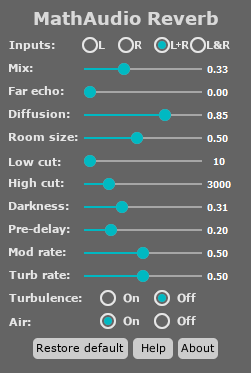
MathAudio Reverb VST/AU
- Applies an algorithmic method of echo synthesis.
- Avoids the metallic timbre of conventional algorithmic reverbs.
- Provides a sense of space and natural depth. Compare the sound before the reverb with the sound after the reverb.
- Works with zero latency. Suitable for live performances and direct monitoring.
- Applies 64-bit signal path throughout.
- Supports full range of sample rates from 44,056 kHz up to 384 kHz (88.2 kHz or higher recommended).
MathAudio Reverb controls
1. Inputs
Selects the source of the audio signal: L (left channel), R (right channel), L+R (sum) or L&R (stereo).
2. Mix
Adjusts the balance of the "wet" and "dry" signals.
3. Far echo
Controls the level of the far echo.
4. Diffusion
Controls the "reflectivity of the walls". Changes the density of the echo. Reducing diffusion creates more discrete echoes, and vice versa. A larger setting of Diffusion corresponds to a longer decay.
5. Room Size
Controls the lengths of the delay lines. A larger setting of Room Size corresponds to a longer decay and a bigger room sound.
6. Low Cut
Adjusts the cutoff frequency of a highpass filter in the signal path.
7. High Cut
Adjusts the cutoff frequency of a lowpass filter in the signal path.
8. Darkness (High Damping)
Adjusts damping of the high frequencies in the reverb signal. Damping refers to the rate at which the high frequencies decay. This effect causes the sound to become gradually muffled and warmer.
9. Pre-delay
Adjusts the initial delay of the echo.
10. Mod Rate
Controls the rate at which modulation changes occur.
11. Turb Rate (Turbulence Rate)
Controls the average rate at which echo anomalies occur.
12. Turbulence
Adds random anomalies to the echo.
13. Air
Adds some "air" to the echo.
14. Restore default
Restores the factory preset.
